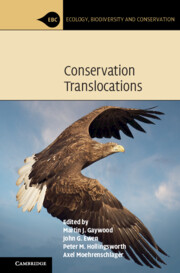Book contents
- Frontmatter
- Dedication
- Contents
- Contributors
- Foreword
- Preface
- Acknowledgements
- Part I Conservation Translocations: Getting Started
- Part II Conservation Translocations: The Key Issues
- Part III Conservation Translocations: Looking to the Future
- Part IV Case Studies
- 14 Reintroduction of the Endemic Plant Manglietiastrum sinicum (Magnoliaceae) to Yunnan Province, China
- 15 Applying Adaptive Management to Reintroductions of Pyne’s Ground-Plum Astragalus bibullatus
- 16 Five Reasons to Consider Long-Term Monitoring: Case Studies from Bird Reintroductions on Tiritiri Matangi Island
- 17 Multiple Reintroductions to Restore Ecological Interactions in a Defaunated Tropical Forest
- 18 Bringing Jaguars and Their Prey Base Back to the Iberá Wetlands, Argentina
- 19 The Return of the Eurasian Beaver to Britain: The Implications of Unplanned Releases and the Human Dimension
- 20 The Role of Community Engagement in Conservation Translocations: The South of Scotland Golden Eagle Project (SSGEP)
- 21 The European Native Oyster and the Challenges for Conservation Translocations: The Scottish Experience
- 22 Slow and Steady Wins the Race: Using Non-native Tortoises to Rewild Islands off Mauritius
- 23 Assisted Colonisation as a Conservation Tool: Tasmanian Devils and Maria Island
- Index
- Plates
22 - Slow and Steady Wins the Race: Using Non-native Tortoises to Rewild Islands off Mauritius
from Part IV - Case Studies
Published online by Cambridge University Press: 07 December 2022
- Frontmatter
- Dedication
- Contents
- Contributors
- Foreword
- Preface
- Acknowledgements
- Part I Conservation Translocations: Getting Started
- Part II Conservation Translocations: The Key Issues
- Part III Conservation Translocations: Looking to the Future
- Part IV Case Studies
- 14 Reintroduction of the Endemic Plant Manglietiastrum sinicum (Magnoliaceae) to Yunnan Province, China
- 15 Applying Adaptive Management to Reintroductions of Pyne’s Ground-Plum Astragalus bibullatus
- 16 Five Reasons to Consider Long-Term Monitoring: Case Studies from Bird Reintroductions on Tiritiri Matangi Island
- 17 Multiple Reintroductions to Restore Ecological Interactions in a Defaunated Tropical Forest
- 18 Bringing Jaguars and Their Prey Base Back to the Iberá Wetlands, Argentina
- 19 The Return of the Eurasian Beaver to Britain: The Implications of Unplanned Releases and the Human Dimension
- 20 The Role of Community Engagement in Conservation Translocations: The South of Scotland Golden Eagle Project (SSGEP)
- 21 The European Native Oyster and the Challenges for Conservation Translocations: The Scottish Experience
- 22 Slow and Steady Wins the Race: Using Non-native Tortoises to Rewild Islands off Mauritius
- 23 Assisted Colonisation as a Conservation Tool: Tasmanian Devils and Maria Island
- Index
- Plates
Summary
The radiated tortoise and Aldabra giant tortoise were used as ecological replacements for the extinct Mauritian tortoise Cylindraspis inepta. Aldabra giant tortoises were better adapted as seed dispersers and grazers, and have become the species of choice. It is intended to remove the radiated tortoises from Round Island. It is suggested there was an open grazing climax plant community maintained by tortoises with heliophilous native plants that have adaptations to avoid being grazed or browsed and respond to grazing with prostrate growth form. The Aldabra giant tortoises fed on fallen fruits and spread the seeds of hardwood trees, screw-pines and palms in their droppings that subsequently demonstrated enhanced germination and growth rates. Preliminary work was done on Ile aux Aigrettes before the release on Round Island. The tortoises have established grazed areas colonised by the native tussock grass Chrysopogon argutus that the tortoises do not graze and is benefiting from reduced competition from the fast-growing non-native grasses.
Keywords
- Type
- Chapter
- Information
- Conservation Translocations , pp. 469 - 475Publisher: Cambridge University PressPrint publication year: 2022
- 1
- Cited by

